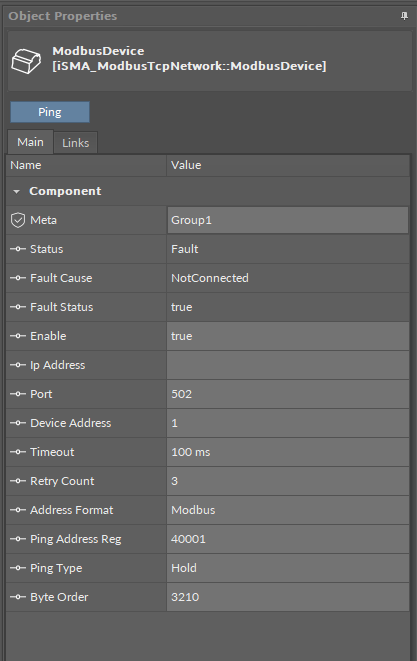The ModbusDevice is a component which is responsible for servicing physical Modbus TCP slave devices. Each Modbus device is represented by an IP address, port number (default for Modbus 502), and Device address (1 to 247).
The component has a Ping action available under the right-click, which sends a test message to the device to check the device status. Each ModbusDevice has a “Ping Address” container slot with 3 properties slots (Address Format, Ping Address Reg, Ping Type). These properties specify a particular data address (either input register or holding register) to use as the device status test (meaning “Monitor” ping requests). Ping requests are generated at the network-level by the configurable network monitor (ModbusNetwork -> Ping Enabled). When enabled, a network’s monitor periodically pings (queries) this address. If any response id received from the device, including an exception response, this is considered a proof of communication, and the Modbus client device is no longer considered “down” if it had been previously marked “down”.

The ModbusDevice component has the following slots:
-
Status: Device’s actual status (read-only);
-
Available states: OK (device is working properly), Disable (device is disabled, the Enable slot is in false), Down (device is not available), Ok, some points down/error (error in points reading), Network disabled (Modbus network is disabled);
-
-
Fault Cause: fault cause description;
-
Fault Status: device error status;
-
Available states: true (device communication error), false;
-
-
Enable: enables/disables the device;
-
IP Address: slave device (gateway) IP address;
-
Port: slave device (gateway) Modbus TCP port number (default 502);
-
Device Address: Modbus device address (0 - broadcast, 1-248 addressing range);
-
Timeout: max. device response time from the device request;
-
Inter Message Delay: time between messages sent to the device;
-
Retry Count: max. number of error messages (CRC error, lost messages);
-
Address Format: Modbus address format (Modbus, decimal);
-
Ping Address Reg: any register (Input/Holding) number for device connection test;
-
Ping Type: tested register type: Input/Holding;
-
Byte Order: byte reading order , for32-bit: 3210 (Big endian), 1032 (Little endian).
